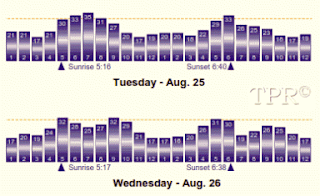 |
| Source: Bespoke (Feb 27, 2017) |
Showing posts with label Intraday. Show all posts
Showing posts with label Intraday. Show all posts
Tuesday, February 28, 2017
The “Gone Fishing” Market
Labels:
Bespoke,
Intraday,
SPX,
US-Stocks,
Volatility
Wednesday, August 26, 2015
SPX vs Planetary Hours + SoLunar Intraday Map (Aug 25-26)
Labels:
AstroFin,
Financial Astrology,
Intraday,
Planetary Hours,
SoLunar Intraday Maps,
SoLunar Map,
SPX
Wednesday, July 15, 2015
Planetary Hours
 One fundamental principle of cognition is the scission of the Monad into two parts of symbolic opposites: hot and cold, light and dark, hard and soft, raw and cooked, good and evil. The division of the day into planetary hours is based on this way of thinking: the cycle of the day is split into a dark and a light part. The light part is defined by the length of time between sunrise and sunset and the dark part comprises the hours between sunset and sunrise. And since the length of day and night is only equal at the equinoxes, whereby its opposite, the longest day and shortest night or vice versa occurs at the solstices, William Lilly wrote in his Christian Astrology:
One fundamental principle of cognition is the scission of the Monad into two parts of symbolic opposites: hot and cold, light and dark, hard and soft, raw and cooked, good and evil. The division of the day into planetary hours is based on this way of thinking: the cycle of the day is split into a dark and a light part. The light part is defined by the length of time between sunrise and sunset and the dark part comprises the hours between sunset and sunrise. And since the length of day and night is only equal at the equinoxes, whereby its opposite, the longest day and shortest night or vice versa occurs at the solstices, William Lilly wrote in his Christian Astrology: |
| 1 Planetary Hour = (Sunset - Sunrise) / 12 |
 |
| Watch rulers of days, hours and signs, especially beginnings of Sun and Moon hours as well as rise, culmination and set of planets. |
This order is known as the “Chaldean Order”, derived from the planets' relative mean speeds which are important in horary astrology (HERE).
Calculation of the planetary hours played a certain role in Renaissance astrology and magic. Astronomical tables published in the late 15th or during the 16th century often included a table of planetary hours with their significations.
Labels:
AstroFin,
Chaldean Order,
Gottfried Wilhelm Leibniz,
Horary Astrology,
In Mundo,
Intraday,
Key of Solomon,
Planetary Hours,
Pythagoras,
Timing Solution,
William Lilly
Subscribe to:
Posts (Atom)


